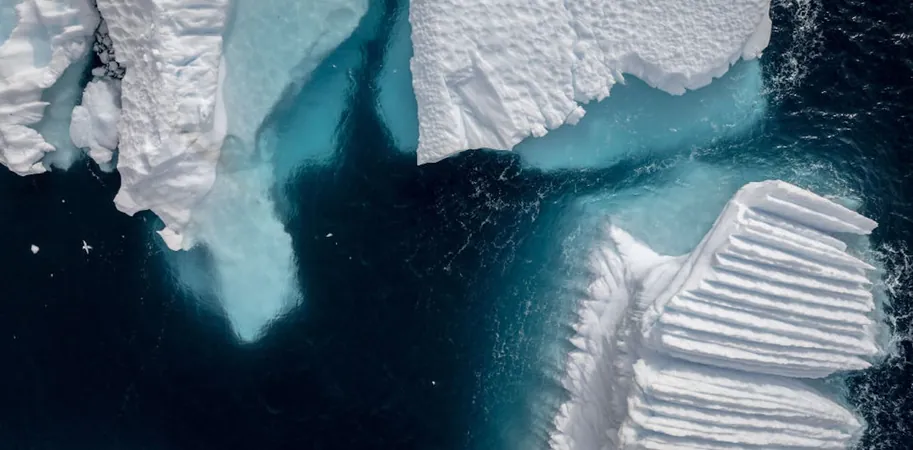
Climate Shift: Melting Ice Could Bring Soaking Monsoons to Northern Australia While Draining the Tropics
2025-07-10
Author: Noah
Imagine a world where rising temperatures not only reshape landscapes but also alter weather patterns dramatically! Nearly two-thirds of the global population relies on seasonal monsoons, those torrential downpours that mark summer months in the northern and southern hemispheres. While the East Asian monsoon takes the spotlight, it turns out the less-studied Indo-Australian monsoon has a crucial role in influencing weather across northern Australia, Indonesia, and Papua New Guinea.
Unveiling Hidden Secrets from the Past
To peel back the layers of history, researchers meticulously analyzed sediment from an ancient lagoon near Darwin, Australia. By examining the remnants of ancient pollen and chemical isotopes, they uncovered evidence of monsoon changes dating back 150,000 years. Each shift in pollen types provides clues about past climates—drier conditions promote grasslands, while wetter ones encourage rich forests.
Indo-Australian Monsoon: A Rising Star
As our planet heats up, the findings indicate a dramatic intensification of the Indo-Australian monsoon, forecasting wetter conditions for northern Australia. This revelation stands in stark contrast to predictions for the East Asian monsoon, which may weaken, posing threats to agriculture and ecosystems in heavily populated regions.
Exploring Girraween Lagoon's Rich History
Girraween Lagoon, a treasure trove of environmental data, has remained undisturbed for millennia. Formed over 200,000 years ago, this lagoon has preserved a continuous record of climatic shifts, providing a goldmine of information for climatologists. By extracting a core sample, researchers unlocked a time capsule revealing changes in flora and fauna linked to monsoon patterns.
From Grassy Savannahs to Lush Forests
Fast forward to today, and Girraween Lagoon is surrounded by thick greenery. Yet, during the last ice age, it sat over 300 kilometers from the coast, encircled by sparse grasslands and a smattering of shorter trees. Remarkably, the lagoon experienced significant transformations—about 115,000 years ago, it transformed into an expansive lake embraced by lush monsoon forests, devoid of grass.
Ice Melting and Weather Patterns: The Connection
The research also uncovered a surprising link between melting ice sheets in the Northern Hemisphere and monsoonal rainfall in Australia. Such melting, referred to as Heinrich events, releases vast amounts of freshwater into the North Atlantic, disrupting ocean currents like the Gulf Stream and altering global temperatures. This ripple effect results in increased rainfall in northern Australia, showing a critical interplay between distant ice melt and local weather.
What Lies Ahead for Northern Australia?
These findings point to an increasingly intense Indo-Australian monsoon—great news for northern Australia as rainfall could soar. However, the implications for southern regions remain uncertain as researchers continue to scrutinize shifting weather patterns. Recent statistics have already shown a continuous increase in rainfall over northern Australia since the 1960s, contrasted with drier conditions in the southeast and southwest.
So, what’s the takeaway? A burgeoning monsoon in Australia’s tropical north presents exciting possibilities, yet it’s a double-edged sword. With few people inhabiting these regions, the immediate human impact may be minimal, but significant changes could reshape ecosystems and livelihoods far beyond.









 Brasil (PT)
Brasil (PT)
 Canada (EN)
Canada (EN)
 Chile (ES)
Chile (ES)
 Česko (CS)
Česko (CS)
 대한민국 (KO)
대한민국 (KO)
 España (ES)
España (ES)
 France (FR)
France (FR)
 Hong Kong (EN)
Hong Kong (EN)
 Italia (IT)
Italia (IT)
 日本 (JA)
日本 (JA)
 Magyarország (HU)
Magyarország (HU)
 Norge (NO)
Norge (NO)
 Polska (PL)
Polska (PL)
 Schweiz (DE)
Schweiz (DE)
 Singapore (EN)
Singapore (EN)
 Sverige (SV)
Sverige (SV)
 Suomi (FI)
Suomi (FI)
 Türkiye (TR)
Türkiye (TR)
 الإمارات العربية المتحدة (AR)
الإمارات العربية المتحدة (AR)